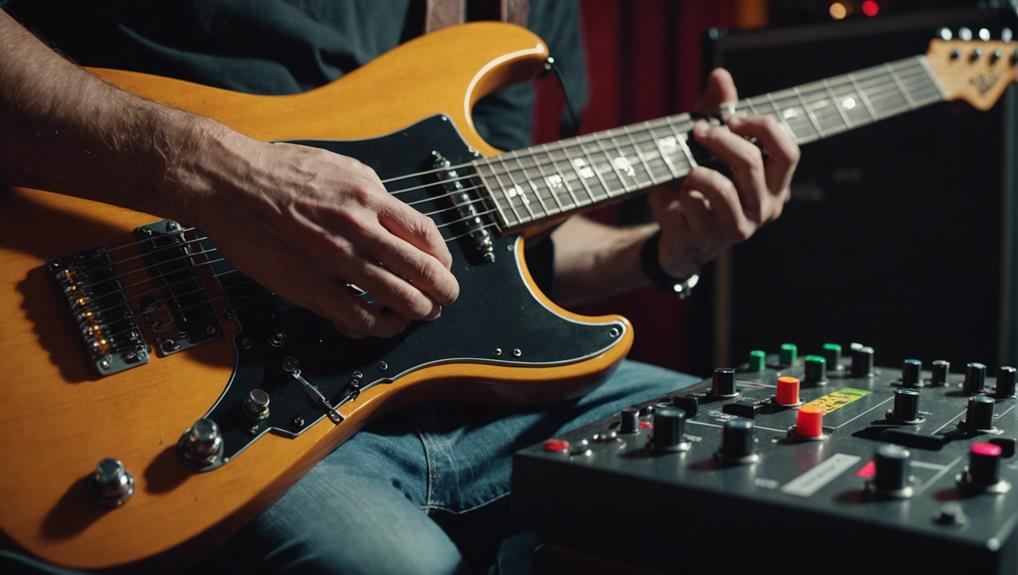If you’ve ever struggled with slow and clumsy chord changes on the guitar, you’re not alone. Speeding up these progressions is essential for fluid play and can be achieved through mastering basic chord shapes, refining finger placements, and employing strategic techniques like the pivot method.
But before you reach for your guitar, consider how reducing finger pressure and lifting fingers strategically can streamline your practice. Slow, deliberate practice may seem tedious, but it’s key to developing muscle memory and precision.
Ready to make your chord changes seamless? Let’s explore some effective guitar exercises and techniques that can help you achieve this.
TL-DR
- Practice slow, deliberate chord changes to build muscle memory and precision.
- Use the pivot method to minimize unnecessary finger movements and speed up transitions.
- Lift fingers strategically on the last upstroke to ensure smoother chord changes.
- Utilize a metronome to maintain consistent timing and gradually increase speed.
- Identify and focus on common notes between chords to reduce finger movement and enhance efficiency.
Understand Basic Chord Shapes
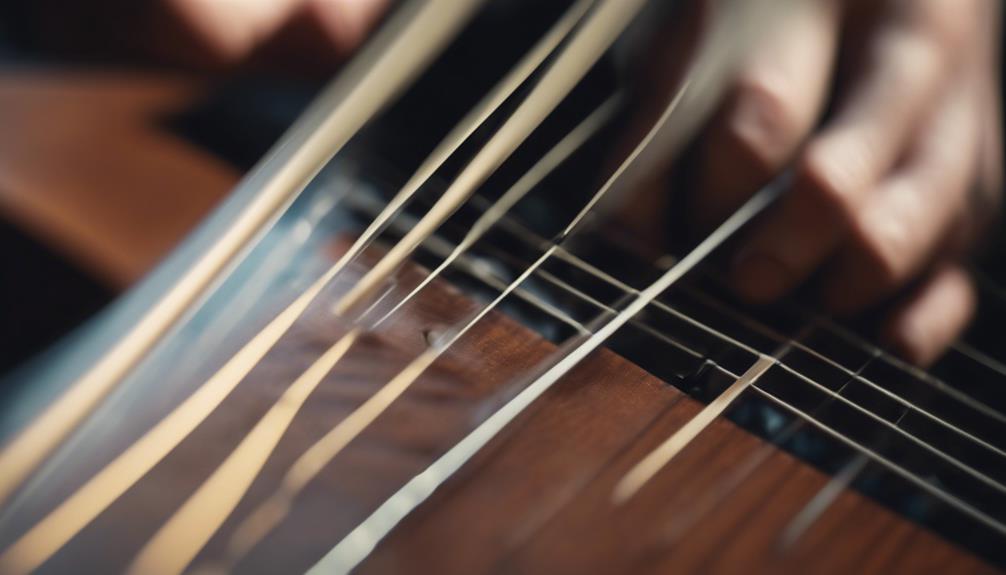
To speed up your guitar chord changes, start by mastering basic chord shapes like E major, A major, and D major. These foundational chords are essential for many songs and provide a solid base for your playing.
First, understand the finger placements and fret positions for each chord shape. For E major, place your fingers correctly on the second fret of the A and D strings, and the first fret of the G string. For A major, your fingers should press down on the second fret of the D, G, and B strings. Lastly, for D major, place your fingers on the second fret of the G and E strings and the third fret of the B string.
Practice switching between these basic chords slowly and deliberately. Focus on the precision of your finger movements and aim for a clean sound without any buzzing or muting. As you become more comfortable, gradually increase your speed. It’s essential to maintain accuracy as you improve. Don’t rush; ensure each chord sounds clear and distinct.
Consistent practice with these fundamental shapes will greatly enhance your ability to change chords quickly and smoothly.
Use the Pivot Method
The Pivot Method can greatly enhance your chord changes by minimizing unnecessary finger movements. This technique involves leaving one or two fingers in the same position when switching between chords. By using a pivot finger, you can anchor certain fingers on the fretboard, which helps you quickly get the rest of your fingers into the correct position for the new chord.
Imagine you’re switching from a G chord to a C chord. Instead of lifting all your fingers off the strings, keep your ring finger on the third fret of the B string. This pivot finger acts as an anchor, making it easier to place the other fingers correctly without losing your hand’s orientation on the neck.
Professionals often use this method to achieve smoother and faster switches, ensuring better chord integrity and reducing overall hand movement.
Another benefit of the Pivot Method is that it streamlines the process of changing chords efficiently, allowing you to maintain a steady rhythm and flow in your playing. By incorporating this approach into your practice, you’ll find yourself making quicker and more accurate chord changes, contributing to a more polished and professional sound.
Minimize Finger Pressure
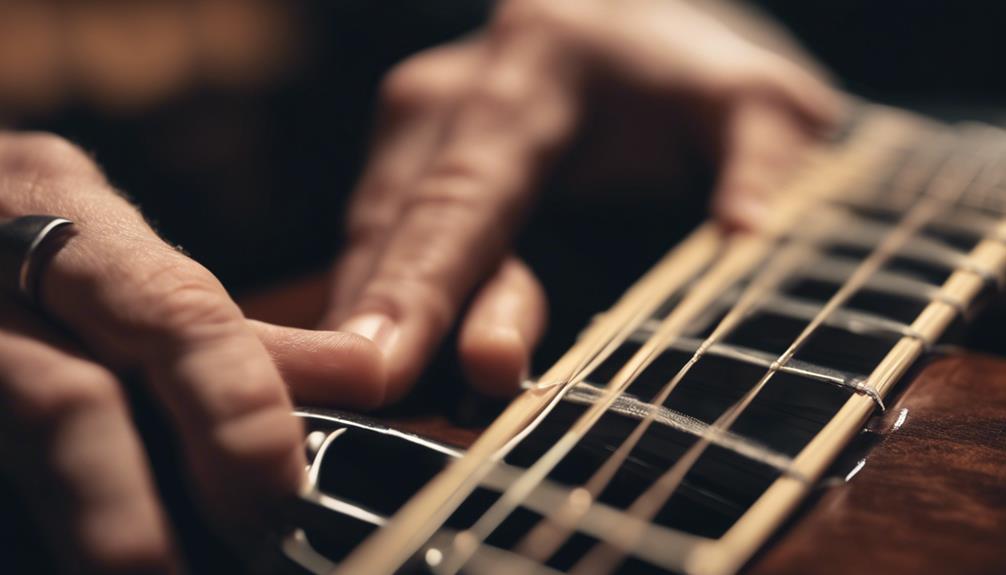
Reducing the amount of pressure you apply on the fretboard can greatly speed up your chord changes. When you use minimal finger pressure, you reduce the tension in your hand and fingers, allowing for quicker and more accurate shifts between chords. This technique helps prevent fatigue, enabling you to practice longer and improve faster.
To find the least amount of pressure needed, start by pressing down on a string just enough to get a clean note without any buzzing. You’ll notice that you don’t need to press as hard as you might think. By applying just the necessary pressure, you guarantee a lighter touch on the strings, which makes your movements smoother and quicker.
Playing with minimal finger pressure not only speeds up your chord changes but also promotes better finger dexterity. This lighter touch helps you move effortlessly from one chord to another, enhancing both speed and efficiency. Plus, it maintains the sound quality of your chords, making sure that each note rings out clearly.
Incorporate this approach into your practice sessions to experience a noticeable improvement in your chord changes. Emphasizing minimal finger pressure will make your playing more comfortable and enjoyable, helping you become a more proficient guitarist.
Lift Fingers Strategically
Lift your fingers off the fretboard on the last upstroke before switching chords to allow time for repositioning efficiently. This technique, often used by professionals, can greatly speed up your chord changes. By lifting your fingers strategically, you create a smoother shift and reduce the chances of fumbling during changes.
When you implement the lift up method, you’ll notice an immediate improvement in the fluidity of your playing. Here’s how to visualize it:
- Imagine a dancer moving gracefully from one position to another: Your fingers should move with the same fluidity.
- Visualize a relay race baton handoff: The smooth exchange between runners is akin to how your fingers should move between chords.
- Think of a painter’s brush strokes: Each lift and place is deliberate, creating a cohesive picture.
Slow Practice for Precision

Practicing slowly allows you to focus on precise finger placement and smooth chord changes. Slow practice is vital for developing muscle memory, which guarantees your fingers know exactly where to go without hesitation.
By playing chords at a reduced speed, you can pay close attention to each finger’s position, making sure they land accurately on the strings and frets.
When you take the time to practice slowly, you can easily identify and correct any mistakes in your fingering. This method prevents the formation of bad habits that can be hard to break later on. Remember, the precision you gain through slow practice translates directly to faster and more efficient chord changes when you eventually pick up the tempo.
Start by practicing at a tempo where you can change chords comfortably and correctly. As you become more confident and consistent, gradually increase the speed. This incremental approach helps you maintain accuracy while improving your overall performance. Your fingers will naturally become more agile and responsive, making chord changes feel effortless over time.
Incorporating slow practice into your routine may seem tedious, but it’s a proven technique that leads to significant improvements in your guitar playing skills.
Develop Finger Independence
To develop finger independence, focus on finger strength exercises and isolate challenging shifts in your practice.
Use slow practice drills to enhance precision and control in your movements.
Finger Strength Exercises
Improving your fingers through specific exercises is essential for achieving faster and more accurate guitar chord shifts. Practicing finger strength exercises can greatly enhance your performance. Start with finger lifts and spider walks to strengthen each finger individually. These exercises help you develop finger independence, making chord changes smoother.
Additionally, use a hand grip strengthener to boost your overall finger strength. This tool is particularly effective for increasing the power and endurance of your fingers, which is vital for maintaining consistent pressure on the strings.
Incorporate these exercises into your routine:
- Finger lifts: Lift each finger off the fretboard independently while keeping the others down.
- Spider walks: Move your fingers in a coordinated pattern up and down the fretboard.
- Hand grip strengthener: Squeeze the tool regularly to build finger strength and endurance.
Don’t forget to include finger stretching routines to increase your flexibility. As your strength and flexibility improve, gradually increase the difficulty of your exercises.
Consistent practice of these finger strength exercises will lead to quicker and more precise chord shifts over time, making your playing smoother and more enjoyable.
Isolate Difficult Transitions
After building finger strength, it’s important to focus on isolating the challenging chord changes that frequently trip you up. Start by identifying which shifts are the most difficult for you. These could be switches between chords like F and Bm, or any other pairs that cause you to stumble.
Once you’ve pinpointed these tricky spots, you can work on developing finger independence to make the changes smoother.
To isolate challenging shifts, practice moving between the problematic chords slowly and deliberately. Break down each movement, focusing on how each finger needs to move from one position to the next. This will help you target specific areas for improvement and build muscle memory. By doing this, you’re essentially retraining your fingers to move more efficiently.
Don’t try to tackle all your challenging shifts at once. Work on each one individually. Spend dedicated time on just one switch until it feels natural and fluid.
Gradually incorporate these challenging shifts into your regular practice routine. The more you practice isolating challenging changes, the more comfortable and confident you’ll become at changing chords, leading to smoother and faster overall performance.
Slow Practice Drills
Slow practice drills are vital for developing finger independence and achieving smoother chord changes. By focusing on slow practice drills, you can guarantee each finger moves independently and accurately to its target fret and string.
Start by practicing individual finger movements with exercises like spider walks or finger independence drills. These drills will train your fingers to operate independently, which is essential for clean and efficient chord shifts.
When you slow down your chord changes, you can concentrate on proper finger placement and coordination. Here are some tips to help you:
- Use a metronome: Set it to a slow tempo and gradually increase the speed as you become more comfortable.
- Aim for precision: Ensure each finger lands on the correct string and fret without any unnecessary movement.
- Consistent practice: Make slow practice drills a regular part of your routine to build muscle memory.
Identify Common Notes

To speed up your chord changes, start by identifying shared finger positions between chords. These common notes act as pivot points, making shifts smoother and quicker.
Practice focusing on these shared notes to reduce finger movement and enhance your playing efficiency.
Shared Finger Positions
Identifying shared finger positions between chords can greatly accelerate your chord changes. By focusing on the common notes that multiple chords share, you can establish anchor points that make switching smoother and faster.
Recognizing these shared finger positions helps your muscle memory, allowing you to shift seamlessly between chords.
When you practice, look for chords that have overlapping notes and utilize the same finger for these notes.
For example:
- G and D: Both chords often use the third finger on the third fret of the second string.
- C and Am: Use the first and second fingers on the first and second frets of the second and fourth strings, respectively.
- E and A: Share the first finger on the first fret of the third string.
Pivot Point Techniques
Using pivot point techniques can significantly speed up your chord changes by keeping one or more fingers in place. When you identify common notes between two chords, you can use a pivot finger to anchor your hand, making shifts smoother and quicker.
For instance, if you’re moving from a G to a D chord, your ring finger can remain on the third fret of the B string, acting as that pivot point.
Recognizing these shared notes or finger placements is essential. It streamlines the process of switching chords, reducing the movement your hand has to make. This technique isn’t just for beginners; even advanced players use pivot fingers to maintain continuity and fluidity in their playing.
To apply pivot finger techniques effectively, start by examining the chords you’re working on. Find any common notes or finger placements. Practice keeping your pivot finger in place while moving the other fingers. This not only saves time but also helps in building muscle memory.
Smooth Transition Practice
Spotting common notes between chord shapes can greatly enhance your ability to switch smoothly and quickly. These common notes act as pivot points, allowing you to shift effortlessly between chords. By recognizing and using these shared notes, you’ll maintain better hand position stability, which is vital for rapid changes.
To practice this technique, identify the common notes in the chords you’re working on. For example, if you’re switching between G and D, the D note on the second string can serve as your pivot finger. This approach not only helps with maintaining finger placement but also strengthens muscle memory.
Here’s how you can get started:
- Identify Shared Notes: Look for notes that are common in both chords. This identifies your pivot finger.
- Practice Transitions: Move back and forth between the chords, focusing on keeping the pivot finger in place.
- Increase Speed Gradually: Start slow to guarantee accuracy, then gradually increase your speed.
Practice Without a Guitar
Even without your guitar, you can still practice chord changes by visualizing shapes and finger placements to reinforce muscle memory. This mental practice can greatly enhance your chord switches. Start by picturing your hand on the fretboard, imagining the exact placement of each finger for different chords.
Use an air guitar or pretend you’re fretting an actual chord. Move your fingers as if you’re playing, ensuring you accurately mimic the shifts and finger movements. This technique helps solidify the muscle memory needed for smooth chord adjustments.
Mentally go through different chord shifts, focusing on finger positioning and hand placements. Close your eyes and visualize each change, paying attention to which fingers move and which stay anchored. This mental rehearsal can make your physical practice more effective.
You can also practice chord progressions in your mind. Imagine the sequence of chords and how your fingers will move from one to the next. This will improve your speed and accuracy without needing the instrument in hand.
Additionally, think through strumming patterns and chord adjustments. Visualizing the rhythm and movement will enhance your coordination and timing away from the guitar, making your actual practice sessions more efficient.
Simplify Complex Chords

Simplifying complex chords by focusing on the essential notes can make your shifts much smoother. Sometimes, those elaborate chords with all their extra notes can slow you down. By zeroing in on the core notes, you’ll find your chord changes becoming quicker and more fluid.
Think about triads, which are just three-note chords. They’re simpler to play and can greatly enhance your speed.
Here are some ways to simplify complex chords:
- Remove unnecessary notes: Streamline your playing by keeping only the most critical notes.
- Break down barre chords: Simplify these chords into smaller, more manageable forms.
- Focus on essential notes: Concentrate on the notes that define the chord’s character.
Use a Metronome
Using a metronome can greatly improve your chord changes by helping you establish consistent timing. Start with a slow tempo to guarantee accuracy, then gradually increase the speed as you become more comfortable.
This method not only builds muscle memory but also tracks your progress and enhances precision.
Establish Consistent Timing
Practicing with a metronome is crucial for establishing consistent timing in your guitar chord changes. When you’re working on chord shifts, a metronome guarantees you stay on beat and don’t rush or lag behind. This not only helps improve your rhythm but also enhances your overall playing accuracy.
Using a metronome, you can:
- Train your muscle memory: Repeatedly practicing with a metronome allows your fingers to learn smooth and efficient chord shifts.
- Track your progress: By keeping a steady tempo, you can easily notice improvements and pinpoint areas that need more work.
- Prepare for playing with others: Consistent timing is essential when you play with other musicians or in a band setting, making you a reliable guitarist.
Starting at a slower tempo allows you to focus on the mechanics of each chord change. As you become more comfortable, the metronome will help you maintain a steady pace, ensuring your shifts are seamless. This consistent practice builds a solid foundation, making it easier to tackle more complex pieces down the line.
Gradually Increase Tempo
Start your practice at a slow tempo to guarantee each chord change is accurate and clean. It’s important to use a metronome right from the beginning. Set it to a comfortable speed where you can easily shift between chords without rushing. This helps you build a solid foundation for fast chord changes.
As you become more comfortable, gradually increase the metronome speed. This incremental increase challenges your muscle memory and pushes your speed limits while maintaining control. By doing this, you make sure that your fast chord changes remain precise and fluid. It’s not just about speed; it’s about maintaining accuracy under pressure.
Using a metronome consistently tracks your progress and improves your timing. It provides a clear metric for how well you’re doing and where you need to improve. Each time you notch up the tempo, you’re not only getting faster but also more confident in your ability to handle rapid transformations.
Train Muscle Memory
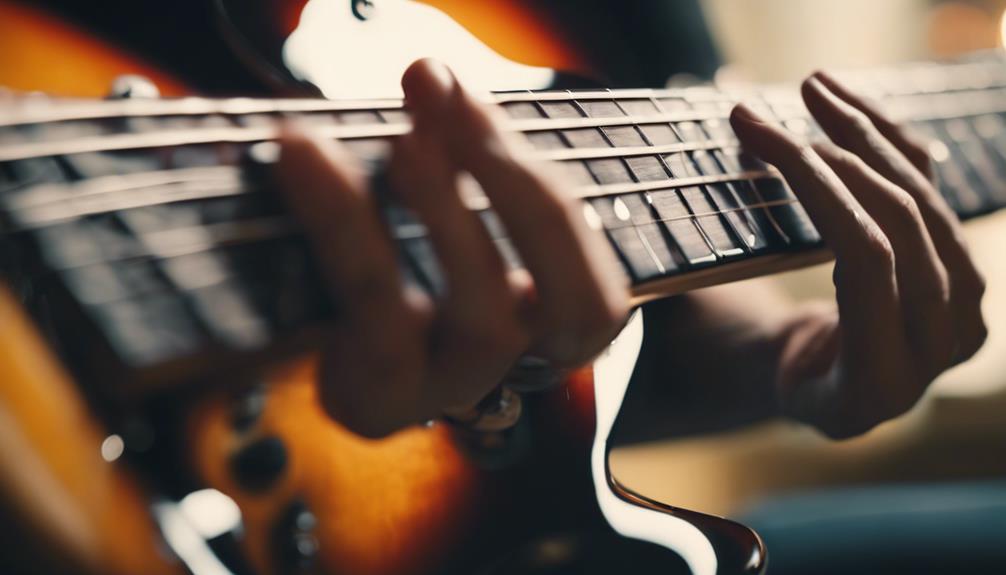
Building muscle memory is crucial for mastering quick and smooth guitar chord changes. When you train muscle memory, you’re effectively teaching your brain and fingers to remember the correct finger placements without having to consciously think about them. This allows for faster and more accurate shifts between chords, making your playing more fluid.
To train muscle memory effectively, consistent repetition is key. Practice changing between chords slowly at first, making sure each finger lands correctly on the strings. Over time, gradually increase your speed while maintaining accuracy.
Here are a few tips to get you started:
- Repetitive Drills: Spend a few minutes each day practicing specific chord changes repeatedly until they feel automatic.
- Use a Metronome: Start slow to ensure precision and gradually increase the tempo as your comfort level improves.
- Visualize the Chords: Before placing your fingers, visualize the chord shape and where each finger needs to go.
Focus on Proper Fingering
Focusing on proper fingering is crucial to speed up your chord changes. Make sure your fingers are placed correctly to minimize unnecessary movement and maintain efficient hand positioning.
Using your fingertips and avoiding dampening adjacent strings will result in cleaner, more accurate chords.
Correct Finger Placement
To master guitar chord changes, it’s essential to focus on correct finger placement, making sure each note rings out clearly and moves smoothly. Concentrating on where and how you place your fingers can make a significant difference in your playing. For most chords, using your fingertips helps you achieve clarity and precision. Press down firmly with the very tips of your fingers to avoid muting adjacent strings unintentionally.
When you’re practicing finger placement, try to:
- Lift unused fingers: This prevents dampening strings that need to ring out.
- Use barre chords correctly: Flatten your index finger properly for clean barre chords.
- Check each note: Strum each string individually to confirm clarity.
Avoid the common mistake of letting your fingers touch strings they shouldn’t. By lifting fingers not in use, you make sure that every note in your chord sounds as intended.
Proper finger placement is especially critical when changing between chords. Clean notes without any dampening will enhance the overall quality of your chord progression, making your music sound more polished and professional.
Keep practicing and refining your technique, and you’ll notice your chord changes becoming quicker and more fluid.
Efficient Hand Positioning
Proper hand positioning plays a pivotal role in speeding up your guitar chord changes and guaranteeing each note rings out clearly. When you place your fingers correctly, you’ll notice a significant improvement in the sound quality of your chords.
Use your fingertips for pressing down the strings. This technique helps in producing clean notes and avoids the issue of dampening adjacent strings. Always check that each finger stays precisely on its designated string and fret.
To further enhance your chord adjustments, make sure that your fingers don’t inadvertently touch other strings. This interference can lead to unwanted muting or buzzing, which can seriously affect your playing. For open chords, focus on keeping your fingers arched and each fingertip firmly pressing down.
Barre chords might be a bit different, requiring you to flatten your index finger across multiple strings. However, for other chords, stick to using your fingertips.
Efficient hand positioning not only makes your adjustments smoother but also boosts the overall quality of your chords. By mastering proper fingering techniques, you’ll be able to execute chord changes quickly and accurately, making your guitar playing more enjoyable and professional.
Minimal Finger Movement
Building on the foundation of efficient hand positioning, minimal finger movement is key to mastering quick and clean chord changes. When you focus on proper fingering, you’ll find that your shifts become smoother and faster.
Here are a few essential tips to keep in mind:
- Place your fingers close to the frets: This reduces the distance they need to travel, minimizing finger movement.
- Use your fingertips: Pressing down on the strings with your fingertips ensures cleaner and quicker shifts.
- Avoid lifting fingers too far off the fretboard: Keeping your fingers close prevents unnecessary movements.
Incorporate Exercises
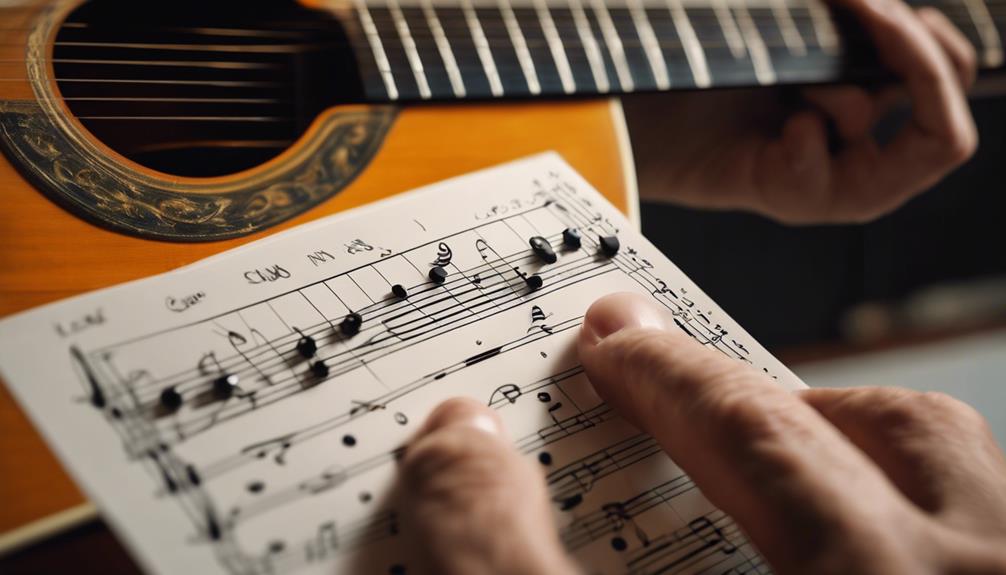
Daily dedication to chord change exercises will rapidly enhance your speed and accuracy. Start by focusing on switching between challenging chord pairs. This targeted approach helps build muscle memory, making the physical process of chord changing more fluid and automatic.
Using a metronome is a game-changer. Begin at a slower tempo to guarantee each chord switch is clean and precise. Gradually increase the speed as you become more comfortable. This method not only improves your timing but also boosts your confidence in playing at faster tempos.
Incorporate finger agility exercises into your routine. These exercises can greatly enhance your dexterity and flexibility, which are vital for faster chord changes. Practice placing each finger individually on the strings, ensuring you can move them quickly and accurately.
Consistent practice with these targeted exercises will lead to significant improvements over time. Remember, the key is persistence. By dedicating a small portion of your daily practice to these exercises, you’ll notice your chord changing speed and accuracy improving steadily. Keep pushing through the initial challenges, and soon enough, those tricky switches will become second nature.
Learn Transition Songs
Changeover songs are a powerful tool for practicing chord changes within a musical context. Conversion songs, which typically involve simple chord progressions that repeat throughout the song, can greatly enhance your ability to switch chords swiftly and smoothly. They provide a real-world application of your skills, making practice more engaging and effective.
By playing conversion songs regularly, you’ll develop muscle memory and speed. This repetition helps your fingers learn where to go without needing to think about it too much.
Some popular conversion songs you might want to try include:
- ‘Knocking on Heaven’s Door’
- ‘Wild Thing’
- ‘Horse with No Name’
These songs aren’t only fun to play, but they also serve as excellent practice tools for mastering chord changes. By focusing on these straightforward tunes, you can concentrate on your conversions rather than getting bogged down by complex rhythms or intricate solos.
Mastering conversion songs will enhance your overall playing skills, making you a more confident and versatile guitarist. Plus, the satisfaction of playing real songs will keep you motivated to continue practicing.
Maintain Regular Practice

To truly master guitar chord changes, you need to practice regularly and consistently. Daily practice builds muscle memory, allowing your fingers to move more fluidly between chords. Even if you only have a few minutes each day, consistent sessions are far more effective than occasional, longer ones.
By repeating chord changes frequently, you’ll notice improvements in both speed and accuracy.
When you practice, focus on challenging shifts. These difficult switches will push you to move your fingers faster and more precisely, improving your overall fluency. Don’t shy away from these tough spots; they’re vital for your growth as a guitarist.
Using a metronome can be particularly helpful. Start at a slow tempo, making sure each chord change is clean and precise. Gradually increase the tempo, pushing your limits and tracking your progress. This systematic approach ensures that your practice isn’t just repetitive but also progressively challenging.
Next up, learn about guitar finger exercises in this guide.


